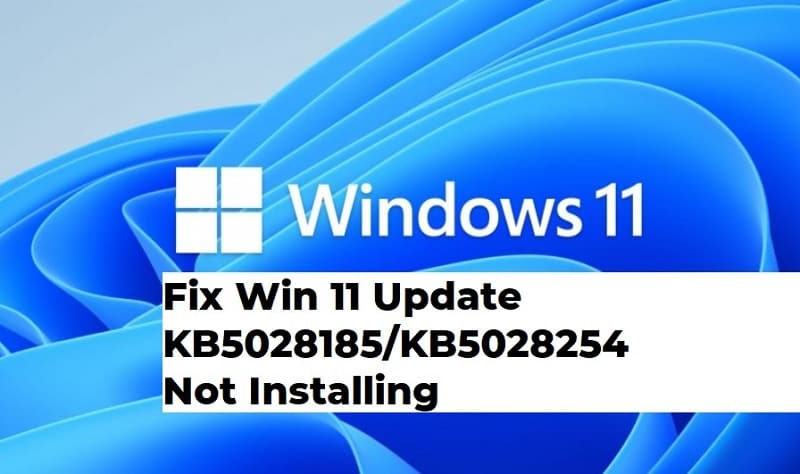Windows 11 is the latest operating system by Microsoft, offering numerous new features and improved performance. Regular updates are essential to keep your system secure and running smoothly. However, some users encounter issues while installing updates like KB5028185 or KB5028254, accompanied by error codes 0x800f081f or 0x800f0988. In this article, we will provide you with a comprehensive step-by-step guide to troubleshoot and fix the Windows 11 update KB5028185/KB5028254 not installing errors 0x800f081f/0x800f0988.
What is Error KB5028185/KB5028254 Not Installing Error 0x800f081f/0x800f0988?
Before diving into the solutions, it’s essential to understand the two error codes:
- Error 0x800f081f: This error indicates that the required files for the update are missing or corrupted, preventing successful installation.
- Error 0x800f0988: This error typically occurs when there are issues with the Windows Update components or when the system can’t access the necessary files for the update.
Step 1: Check System Requirements
Ensure that your system meets the minimum requirements for installing Windows 11 updates. Check for sufficient disk space, a stable internet connection, and compatible hardware components.
Step 2: Run Windows Update Troubleshooter
Windows 11 comes with a built-in troubleshooter that can automatically detect and fix various update-related problems. To run the troubleshooter, follow these steps:
- Press the Windows key + I to open the Settings menu.
- Go to “Update & Security,” then click on “Troubleshoot” from the left pane.
- Select “Windows Update” under “Get up and running,” and click on “Run the troubleshooter.”
- Follow the on-screen instructions to complete the troubleshooting process.
Step 3: Clear Windows Update Cache
A corrupted Windows Update cache can lead to installation issues. Clearing the cache might help resolve the problem. Here’s how to do it:
- Press the Windows key + R to open the Run dialog box.
- Type
services.mscand press Enter. - In the Services window, find and select “Windows Update.”
- Click on “Stop” from the left-hand side to stop the service temporarily.
- Navigate to the
C:\Windows\SoftwareDistributionfolder and delete all its contents. (Note: You may need administrator privileges to perform this action.) - After deleting the contents, go back to the Services window and restart the “Windows Update” service.
Step 4: Use DISM Tool
The Deployment Image Servicing and Management (DISM) tool can fix Windows corruption errors that may hinder update installations. Follow these steps to use DISM:
- Open Command Prompt as an administrator.
- Type the following command and press Enter:
-
DISM /Online /Cleanup-Image /RestoreHealth
- Wait for the process to complete, and then restart your computer.
Step 5: Run System File Checker (SFC) Scan
Running an SFC scan can help repair corrupted system files that might be causing update errors. Here’s how to do it:
- Open Command Prompt as an administrator.
- Type the following command and press Enter:
-
sfc /scannow
- Let the scan run; it may take some time.
- Restart your computer after the scan is complete.
Step 6: Check Disk for Errors
Disk errors can interfere with the update installation process. To check and repair disk errors, follow these steps:
- Press the Windows key + X and select “Windows Terminal (Admin)” to open an elevated Command Prompt.
- Type the following command and press Enter:
-
chkdsk /f
-
- Press “Y” to schedule the disk check for the next system restart.
- Restart your computer.
Step 7: Temporarily Disable Antivirus/Firewall
Sometimes, third-party antivirus or firewall software can conflict with Windows updates. Temporarily disable any security software you have installed and try installing the updates again.
Step 8: Perform a Clean Boot
Performing a clean boot helps eliminate software conflicts that might be causing update installation errors. Here’s how to do it:
- Press the Windows key + R to open the Run dialog box.
- Type
msconfigand press Enter. - In the System Configuration window, go to the “Services” tab, check the “Hide all Microsoft services” box, and then click “Disable all.”
- Next, go to the “Startup” tab, and click “Open Task Manager.”
- In Task Manager, disable all startup items.
- Close Task Manager and click “OK” in the System Configuration window.
- Restart your computer.
Step 9: Use Windows Update Catalog
If the above steps don’t resolve the issue, you can manually download and install the updates from the Microsoft Update Catalog. Visit the official website, search for the update KB5028185 or KB5028254, download the appropriate version for your system, and install it manually.
Step 10: Seek Expert Help
If you have tried all the solutions mentioned above and are still facing issues with the update installation, it’s advisable to seek help from a qualified computer technician or contact Microsoft Support for further assistance.
Step 11: Using Windows 11 Installation Assistant
- Download the Windows 11 Installation Assistant from the official Microsoft website.
- Run the Installation Assistant and follow the on-screen instructions to fix update installation errors.
Step 12: Update Windows 11 Using Media Creation Tool
- Visit the official Microsoft website and download the “Windows 11 Media Creation Tool.” using the second option which is “Create Windows 11 Installation Media.”
- Download the tool and run it on a working computer.
- Accept the terms and conditions, and select the option to “Create installation media (USB flash drive, DVD, or ISO file) for another PC.”
- Choose the language, edition, and architecture (32-bit or 64-bit) that matches your system.
- Select either a USB flash drive or ISO file as the installation media.
- If using a USB flash drive, connect it to the computer, and select the appropriate drive.
- Wait for the Media Creation Tool to download the necessary files and create the bootable media.
- Once the process is complete, restart the computer and boot from the USB drive or DVD.
- Follow the on-screen instructions to install a fresh copy of Windows 11.
- During the installation, you may be prompted to enter your product key. Ensure you have it handy.
- Follow the remaining steps to complete the installation.
- After the installation is finished, reinstall your necessary applications and restore your backed-up files.
Step 13: Resetting Windows Update Components
- Open Notepad and copy the provided commands below.
- SC config trustedinstaller start=auto
net stop bits
net stop wuauserv
net stop msiserver
net stop cryptsvc
net stop appidsvc
Ren %Systemroot%\SoftwareDistribution SoftwareDistribution.old
Ren %Systemroot%\System32\catroot2 catroot2.old
regsvr32.exe /s atl.dll
regsvr32.exe /s urlmon.dll
regsvr32.exe /s mshtml.dll
netsh winsock reset
netsh winsock reset proxy
rundll32.exe pnpclean.dll,RunDLL_PnpClean /DRIVERS /MAXCLEAN
dism /Online /Cleanup-image /ScanHealth
dism /Online /Cleanup-image /CheckHealth
dism /Online /Cleanup-image /RestoreHealth
dism /Online /Cleanup-image /StartComponentCleanup
Sfc /ScanNow
net start bits
net start wuauserv
net start msiserver
net start cryptsvc
net start appidsvc
- SC config trustedinstaller start=auto
Method 2
- Open the Command Prompt as an administrator.
- Type the following commands one by one, pressing Enter after each:
- net stop wuauserv
- net stop cryptSvc
- net stop bits
- net stop msiserver
- Next, type ren C:\Windows\SoftwareDistribution SoftwareDistribution.old and press Enter.
- Then, type ren C:\Windows\System32\catroot2 catroot2.old and press Enter.
- Finally, restart the services by typing the following commands:
- net start wuauserv
- net start cryptSvc
- net start bits
- net start msiserver
- Close the Command Prompt and attempt to install the update again.
- Now, save the file with the name “Wufix.bat” on your desktop.
- Right-click on the Wufix file and click “Run as administrator.”
- The commands will stop relevant services, rename folders, and reset Windows Update components.
- Restart your computer after the process is complete.
Conclusion
Updating Windows 11 is crucial for maintaining system security and performance. If you encounter errors like 0x800f081f or 0x800f0988 while installing updates, use the step-by-step guide provided in this article to troubleshoot and resolve the issues effectively.
FAQs
1. Why won’t the Windows 11 update install?
The Windows 11 update might not install due to various reasons, such as missing files, system corruption, or conflicts with third-party software. Following the troubleshooting steps in this article can help you resolve the issue.
2. How long does a Windows 11 update take to install?
The time taken for a Windows 11 update to install varies depending on the size of the update and your internet connection speed. It can take anywhere from a few minutes to several hours.
3. Can I manually install Windows 11 updates?
Yes, you can manually download and install Windows 11 updates from the Microsoft Update Catalog if automatic updates are not working or encountering errors.
4. Will updating Windows 11 delete my files?
No, updating Windows 11 should not delete your files or personal data. However, it’s always a good practice to back up important data before performing any major system updates.
5. How often does Windows 11 receive updates?
Windows 11 receives regular updates, including security patches, bug fixes, and feature enhancements. Updates are typically released on a monthly basis, but the frequency may vary depending on the urgency of the updates.








